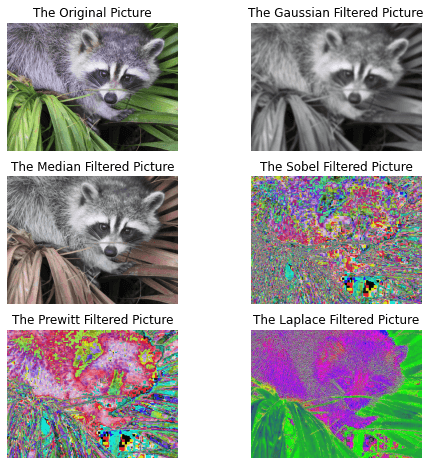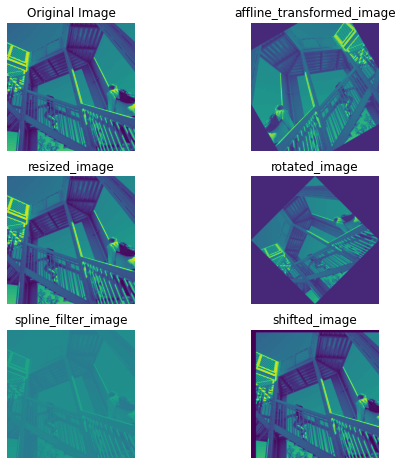Multidimensional image processing using Scipy in PythonIntroductionIn this article, we are discussing Multidimensional image processing using Scipy in Python. SciPy is a Python library used for scientific and technical computing. It is far constructed on top of NumPy, a library for inexperienced numerical computing. It offers many functions for operating with arrays, numerical optimization, signal processing, and different not unusual responsibilities in clinical computing. Photo processing and evaluation are normally seen as operations on 2-D arrays of values. There are several fields where pix of higher dimensionality should be analysed. Examples of these are scientific imaging and biological imaging.numpy is appropriate for this type of program because of its inherently multidimensional nature. The scipy.ndimage programs present some of the fashionable photograph processing and analysis capabilities which might be designed to perform with arrays of arbitrary dimensionality. The programs currently consist of capabilities for linear and non-linear filtering, binary morphology, B-spline interpolation, and item measurements. Photo processing is the sector of laptop technological know-how that offers the manipulation, evaluation, and interpretation of images. In image processing, a multidimensional image is a picture that has extra dimensions. This can include photos with more than one colour channel (e.g., purple, inexperienced, and blue channels in a coloration photograph), photographs with more than one-time point (e.g., a video), and photos with more than one spatial dimension (e.g., a 3-D medical imaging test). SciPy affords several features for processing multidimensional photographs, including features for studying and writing pics, image filtering, photograph warping, and picture segmentation. The 'scipy.ndimage' is a module inside the SciPy library that gives abilities for multidimensional photograph processing. It is far constructed on top of NumPy, a library for green numerical computing, and gives many capabilities for working with arrays, such as features for photo processing. Because quite a few operations are feasible, the thing covers several primary operations.
The scipy.ndimage module offers several collective filter-out abilities for duties with smoothing, polishing, and area detection. Here are a few examples of filter functions that might be provided by using scipy.ndimage:
Syntax and parameters of the filter function:1. Laplacian FilterSyntax: The syntax of the Laplacian filter is given below - Parameters: The parameters of the Laplacian filter are - You can specify the size of the filter using the size parameter. This could be a scalar or a tuple of integers. For example, size 3 applies a 3×3 Laplacian filter, and size (3, 5) applies a 3×5 Laplacian filter. 2. Prewitt FilterSyntax: Parameters: The parameters of the Prewitt filter are - If the axis is set to 0 horizontally and 1 vertically, you can choose the filter's orientation. Options with 0 for smoothing, 1 for the first derivative, and 2 for 2nd by-product can help you choose the order of the by-product using the Order parameter. The Mode parameter, which has picks that include reflecting, Wrap, and regular, describes how the rims of the picture are treated. 3. Median FilterSyntax: The syntax of the Median filter is given below - Parameters: The size parameter specifies the size of the filter out. This will be a scalar or a tuple of integers. For instance, length three applies a 3×3 median clear out, and size (3, 5) applies a 3×5 median clear out. The footprint parameter permits you to specify the layout of the filter. This could be a Boolean array or a chain of indices. The Mode parameter specifies how the rims of the photo are handled and the usage of alternatives such as reflect, Wrap, and regular. 4. Gaussian FilterSyntax: The syntax of the Gaussian filter is given below - Parameters: The sigma parameter specifies the standard deviation of the Gaussian characteristic, which determines the quantity of smoothing implemented in the photo. The order parameter allows you to specify the by-product order to be carried out, with alternatives such as zero for smoothing, 1 for the first derivative, and more than one for the second by-product. 5. Sobel FilterSyntax: The syntax of the Sobel filter is given below - Parameters: The parameters of the Sobel filter are - You can specify the direction of the filter using the axis parameter. 0 is horizontal, and one is vertical. Properties are Shared by all Features:All functions percentage some not unusual houses. Appreciably, all capabilities permit the specification of an output array with the output argument. With this argument, you could specify an array so one may be modified in place with the result of the operation. In this case, the result isn't decreased returned. Generally, using the output argument is extra efficient since a current array is used to keep the result. The array's lower back relies on the shape of the operation, but its miles, in most cases, are identical to the form of the input. If the output argument is used, the kind of the result is the same as the sort of the specified output argument. If no output argument is given, it's far away even though it is possible to specify the output's result. This is finished by assigning the favored numpy kind object to the output argument. For example: Program code: Here we are given an example in Python code. The code is given below - Result: Now we are compiling the above code and run it. Then the result is given below - array([ 0, 10, 26, 41, 57, 72, 88, 103, 119, 134, 150, 165, 181,196, 212, 227, 243, 258, 274, 289]) Program Code: Here we are given an example for a snippet showing the implementation of all filters. in Python code. The code is given below - Result: Now we are compiling the above code and run it. Then the output is given below - 
Interpolation of the Image with the help of SciPy:Picture interpolation estimates the values of pixels in a photo primarily based on the values of surrounding pixels. Image interpolation is commonly used for image resizing and image distortion correction. There are numerous interpolation techniques to be had for image processing, including nearest neighbour interpolation, bilinear interpolation, and bicubic interpolation. the choice of interpolation technique can have an effect on the first-rate and smoothness of the ensuing photo, as well as the computational complexity of the interpolation process. Here are the different types of interpolation transforms provided by scipy.ndimage.
Parameters and Syntax of some Interpolation Functions:1. ShiftSyntax: The syntax of the shift function is given below: Parameters: The parameters of the shift feature are given under: The shift parameter specifies the shift quantity as a tuple of floating factor numbers. the primary element specifies the shift within the x route and the second one detail specifies the shift in the y route. 2. Rotate:Syntax: The syntax of the rotate function is given below: Parameters: The parameters of the rotate function are given below: Reshape is the parameter of rotate function. This parameter specifies whether or not to resize the output photograph to healthy the complete turned around image. through default the output picture is the same length as the enter image. 3. Affine TransformationSyntax: The syntax of the affine transformation function is given below - Parameters: The parameters of the affine transformation function are given below: output_shape, output_center and mode - these are the three parameters of affine transformation function. output_shape: This parameter lets in you to specify the size and form of the output picture. Need to be a tuple of integers. output_center: This parameter lets in you to set the middle of the output photo. Must be a tuple of floats. mode: This parameter specifies the way to treat the rims of the picture. alternatives consist of replicate, Wrap, and constant. 4. ZoomSyntax: The syntax of the zoom function is given below - Parameters: The parameters of the zoom function are given below: The zoom parameter specifies a zoom factor that can be a scalar or a tuple of floating-point numbers. As an example, a zoom component of 2 doubles the size of the picture, a zoom component of (2, 1) doubles the width, and leaves the peak unchanged. 5. Spline FilterSyntax: The syntax of the spline function is given below: Parameters: The parameters of the spline function are given below: order is the parameter of the spline function. This parameter permits you to specify which interpolation approach to apply. Options are 0 for nearest neighbour interpolation, 1 for bilinear interpolation, 3 for bicubic interpolation, and so on. Program Code:Here we are given an example for snippet displaying the implementation of all the Interpolation techniques in Python code. The code is given below - Output: Now we compile the above code and run it. Then the result is given below - 
Segmentation of the Image with the help of SciPy:Photograph segmentation is the manner of dividing a picture into distinctive areas or segments based totally on specific standards. it is a common approach used in picture processing and pc vision packages to perceive and extract gadgets or regions of interest in an image. The scipy.ndimage.measurements module of the scipy library provides a number of abilities that may be used for photo segmentation. right here are some examples: scipy.ndimage.measurements.variance: This feature permits you to calculate the variance of the values of an photograph or array. scipy.ndimage.measurements.standard_deviation: This feature permits you to calculate the usual deviation of the values of an image or array. scipy.ndimage.measurements.mean: This selection permits you to calculate the suggest of the values of an image or array. scipy.ndimage.measurements.label: This feature allows you to label related additives in an image. It is some distance regularly used as a preprocessing step for segmenting items in a photograph. scipy.ndimage.measurements.center_of_mass: This function allows you to calculate the center of mass of an picture or location of an image. it can be used to become aware of the locations of gadgets in a photograph. Program Code: Here we are given an example for snippet showing the implementation of the label size feature in Python code. The code is given below - Output: Now we compile the above code and run it. Then the result is given below - 
Program Code: Here we are given an example of the Implementation of several other measurement functionalities provided through the ndimage library shown within the code under Python code. The code is given below - Output: Now we compile the above code and run it. Then the result is given below - The Minimum pixel value of the image is 0.3333333333333333 on the location (567, 258) The Maximum pixel value of the image is 254.0 on the location (245, 568) Mean: 110.16274388631183 Center of Mass: (356.6752247435916, 469.240201083681) Standard Deviation: 54.975712030326186 Variance: 3022.3289132413515 |
 For Videos Join Our Youtube Channel: Join Now
For Videos Join Our Youtube Channel: Join Now
Feedback
- Send your Feedback to [email protected]
Help Others, Please Share










